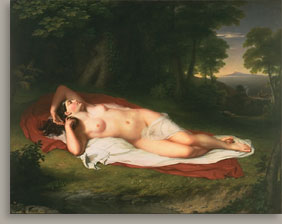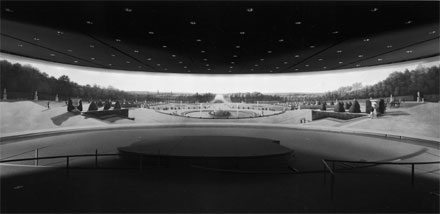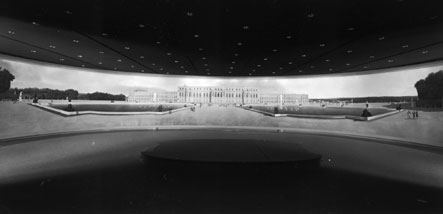| John Vanderlyn Born Kingston, N.Y., October 15, 1775. Died Kingston, N.Y., September 24, 1852. John Vanderlyn earned many distinctions in the history of American art, but he also endured many frustrations as an artist and businessman. He began his professional career in the studio of Gilbert Stuart (1755–1828), and under the patronage of the New York Senator and later Vice President Aaron Burr became the first American painter to study in Paris. Within a few years of his arrival in the French capital, he would also be the first American to exhibit at a French Salon, the first to win a medal at a Salon, and the first successful proponent of a French-inspired neoclassical style. Although his output consisted primarily of portraits, he aspired to elevate American taste through history painting. He also created landscapes in the neoclassical style, including several paintings of Niagara Falls and a panorama of Versailles. Vanderlyn’s failed business ventures included a set of engravings after his views of Niagara and a Rotunda constructed at great expense to display his panorama and easel paintings. Vanderlyn was the son and grandson of painters.1 His father Nicholas (1723–1810) was a glazier-painter and a dealer of painting supplies. His grandfather Pieter (1687–1778) was a Dutch emigré who painted portraits in the patroon tradition in colonial New York. John received a classical education in his hometown at the Kingston Academy, among many children of New York’s elite families.2 By the time he graduated, Vanderlyn knew the rudiments of French and Latin and could speak the English and Dutch languages with which he was raised. In 1791 he purchased Charles Le Brun’s treatise on art Expression des passion de l’âme (1698), from which he copied several of the engravings of emotion-filled facial expressions.3 The following year Vanderlyn apprenticed in New York to a coach painter and print dealer named Thomas Barrow. From 1792 to 1794, Vanderlyn took classes at the Columbian Academy, which had been founded by the Scottish-born painter Archibald Robertson (1765–1835).4 During a visit to his hometown of Kingston, Vanderlyn created his earliest surviving portrait, a stiffly painted likeness of his brother Nicholas Vanderlyn (1793, Senate House State Historic Site, Kingston, New York).5 At Barrow’s shop Vanderlyn met the famous American portraitist Gilbert Stuart, who offered him substantial encouragement. In 1794 Vanderlyn moved into Stuart’s studio, where he saw the noted artist’s portraits of John Jay (1745–1829), Aaron Burr (1756–1836), and other prominent New Yorkers.6 Vanderlyn made copies of Stuart’s portraits of Burr and Judge Egbert Benson. When Burr saw Vanderlyn’s portrait of him, he pledged to pay any expenses necessary for the young artist "to cultivate his genius to [the] highest point of Perfection."7 Burr’s patronage enabled Vanderlyn to rejoin Stuart in Philadelphia, where he helped fill orders for copies of Stuart’s so-called Athenaeum portrait George Washington by blocking in the figure (1796, Museum of Fine Arts, Boston, and National Portrait Gallery, Washington, D.C.).8 Following an extended visit in 1796 to Burr’s New York mansion Richmond Hill, Vanderlyn followed his patron’s advice to study in Paris. He thus became the first American artist to attempt to advance his career in the French capital rather than in London.9 Burr was an ardent Democratic-Republican, and this was an especially partisan time in the wake of the recent Jay Treaty favoring trade with Britain rather than the American Revolutionary ally France. Burr and Vanderlyn believed that Revolutionary France was a more appropriate place than England to develop a national art suitable for the new American republic. Vanderlyn studied for two years in Paris at the Académie de Peinture at the Ecole des Beaux-Arts. He was a pupil there of Francois-André Vincent (1746-1816), a neoclassical painter and admirer of Rubens.10 Vincent, whose studio was in the Louvre, he taught Vanderlyn better draftsmanship, greater command of the human figure, and the importance of history painting.11 In the course of his studies, Vanderlyn made drawings from life, from casts of Antique sculpture, and from Renaissance sculpture; tracings of engravings; and copies after old master paintings.12 Late in 1798 or early in 1799, Burr experienced financial difficulties and had to interrupt his support of Vanderlyn. The artist remained in Paris until 1801 and supported himself with commissions to draw or paint portraits of visiting Americans. Vanderlyn’s sitters for drawings in this period included the American politician Elbridge Gerry (1798, Fogg Art Museum, Cambridge, Mass.), a member of the failed American mission to normalize diplomatic relations between the United States and France.13 During his first two years in France, Vanderlyn vastly refined his ability as a portraitist. With his self-portrait (1800, Metropolitan Museum of Art, New York), which Vanderlyn scholar William T. Oedel considers to be "the masterpiece of Vanderlyn’s first stay in Paris," he earned the distinction in 1800 of being the first American artist to exhibit at the prestigious Paris Salon.14 In 1801 Vanderlyn returned to New York. His prospects for success were heightened by the fact that his patron Burr was now Vice President of the United States under Thomas Jefferson. At the suggestion of Burr, Vanderlyn painted a series of landscapes of Niagara Falls (1801–03).15 In the summer of 1803 the young artist returned to Paris and the following year commissioned engravings based on two of his views of Niagara. Vanderlyn intended the prints to be a profit-making venture, but low sales made them a financial disaster instead.16 Vanderlyn would return to the falls to paint in 1827 and again in 1837. During his 1801–03 interlude in New York, Vanderlyn also created a handful of portraits and received a commission from New York’s Common Council for a portrait of the Federalist John Jay, who feigned illness and thereby refused to sit for the Democratic-Republican, Francophile artist.17 Vanderlyn’s sitters at this time included his longstanding patron Burr and his daughter Theodosia Burr Alston (both 1802, Yale University Art Gallery, New Haven, Conn.). Vanderlyn’s return to Paris in 1803 was funded by Edward and Robert Livingston, who wanted the artist to obtain copies of old master paintings and casts of antique sculpture in Paris, Florence, and Rome for the newly formed New York Academy of Fine Arts.18 Edward was the academy’s first president and was then mayor of New York. His brother Robert was the United States minister to France from 1801 to 1804. In Paris, Vanderlyn painted an impressive three-quarter-length neoclassical portrait of Robert Livingston seated at his desk and looking away from the viewer (1804, New-York Historical Society, New York City). Despite the promise of a handsome salary and a line of credit to obtain casts and copies, the American Academy ended its support of Vanderlyn abruptly in 1804 without notice to the artist.19 At about the same time Vanderlyn painted his first history painting, The Death of Jane McCrea (1804, Wadsworth Atheneum, Hartford, Conn.), as an illustration for Joel Barlow’s epic poem The Columbiad.20 That painting represented an episode from the annals of the American Revolution: Jane McCrea was killed in 1777 by Indians who were allied with the British. That story remained a touchstone of anti-British sentiment throughout the early national period. Vanderlyn had met Barlow in Paris in 1798, when the poet was planning a volume that would be entirely of American production.21 Vanderlyn elevated his subject from illustration to a morally important history painting by basing the poses of the Indians upon such antique models as the Borghese Gladiator.22 Despite the aesthetic success of the painting, Vanderlyn demanded a higher-than-agreed price from Barlow and their relationship was thereby severed. In 1805 Vanderlyn traveled to Rome, where he painted copies after Raphael and Rubens for American patrons.23 Vanderlyn made a concerted effort to study the old masters and also painted several portraits to support his stay in Italy. In Rome Vanderlyn painted his most ambitious history painting to date, Marius Amid the Ruins of Carthage (1807, Fine Arts Museums of San Francisco, California).24 Vanderlyn’s Marius related to the themes of factionalism and the fleeting nature of power, both of which echoed Aaron Burr’s situation after his duel with Alexander Hamilton (1755–1804).25 The subject inspired Vanderlyn, and he was rewarded with accolades in the art press in Rome in 1807 and a medal at the Paris Salon in 1808.26
The most ambitious painting of Vanderlyn’s career was a panorama of the palace and gardens at Versailles (figs. 3a and 3b).28 Landscape had been a part of Vanderlyn’s repertoire since his youth, and his French master Vincent also encouraged his studies of landscape.29 Although he considered making a panorama as early as 1807, he did not begin sketches for the project until 1814, the year before his departure from France. The finished panorama’s realism is heightened by Vanderlyn’s use of a camera obscura in making his studies.30 The monumental painting was created in New York in 1818–19 and spans 165 feet in length (Metropolitan Museum of Art, New York).
The final landmark of Vanderlyn’s career was a commission in 1837 for a mural to be added to the four original murals by Trumbull in the Rotunda of the Capitol.33 Vanderlyn had petitioned Congress in 1824 to paint the Battle of New Orleans, but his bid was rejected. His mural Landing of Columbus at the Island of Guanahani, West Indies, 12 October 1492 (1836–47, U.S. Capitol Rotunda, Washington, D.C.) was one of four paintings ordered by Congress for the Rotunda in 1837. Vanderlyn prepared for his painting by drawing flora in the West Indies and studying a portrait of Columbus in Spain. Despite these efforts toward realism, the composition clearly expresses the subject from a particular cultural viewpoint. Vanderlyn’s painting of Columbus is one of the grandest statements of Manifest Destiny in nineteenth-century American art, and represents the explorer as bringing civilization and Christianity to the Indian world. Notes 2. Oedel 1981, 20–21. 3. Ibid., 23. 4. Ibid., 24–26. 5. Ibid., 30. 6. Ibid., 31. 7. Aaron Burr to Peter Van Gaasbeek, June 21, 1795, quoted in Ibid., 34. 8. Ibid., 38. 9. Ibid., 2, 43–50. 10. Ibid., 64–71. 11. Strickler 1981–82a, 35. 12. Oedel 1981, 76–84. 13. Ibid., 92–94. 14. For Vanderlyn as the first American to exhibit at a Salon, see Oedel 1981, 7; for the quote, Ibid., 107. 15. Ibid., 128–52. 16. Ibid., 203. 17. Ibid., 154. 18. Ibid., 174–79; Strickler 1981–82a, 36–37. 19. Oedel 1981, 213. 20. Ibid., 9. 21. Ibid., 94, 213–38. 22. Ibid., 231–32. 23. Ibid., 247. 24. Strickler 1981–82a, 39. 25. Ibid., 298–311. 26. Ibid., 329–37. 27. Ibid., 350–409. 28. Caldwell and Roque 1994, 257–64. 29. Oedel 1981, 22, 86. 30. Ibid., 415. 31. Ibid., 420–22. 32. Ibid., 434–41. 33. Fryd 1992, 44–46, 54–56. |



